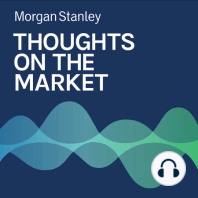3 min listen

The Rising Risk of Global Trade Tensions for Asia
The Rising Risk of Global Trade Tensions for Asia
ratings:
Length:
3 minutes
Released:
Feb 15, 2024
Format:
Podcast episode
Description
Key developments in China and the U.S. will impact global trade and the growth outlook for Asia in 2024.----- Transcript -----Welcome to Thoughts on the Market. I’m Chetan Ahya, Morgan Stanley’s Chief Asia Economist. Along with my colleagues bringing you a variety of perspectives, today I’ll discuss the risk of re-emerging trade tensions and how this might impact the growth outlook for Asia. It’s Thursday, Feb 15, at 9 AM in Hong Kong. Trade tensions took a back seat during the pandemic when supply-chain disruptions led to a mismatch in the supply-demand of goods and created inflationary pressures around the world. However, these inflationary pressures are now receding and, in addition, there are two developments that we think may cause trade tensions to emerge once again. First is China’s over-investment and excess capacity. China continues to expand manufacturing capacity at a time when domestic demand is weakening and its producers are continuing to push excess supply to the rest of the world.China’s role as a large end-market and sizeable competitor means it holds significant influence over pricing power in other parts of the world. This is especially the case in sectors where China’s exports represent significant market share. For instance, China is already a formidable competitor in traditional, lower value-added segments like household appliances, furniture, and clothing. But it has also emerged as a leading competitor in new strategic sectors where it is competing head-on with the Developed Market economies. Take sectors related to energy transition. China has already begun cutting prices for key manufactured goods, such as cars, solar cells, lithium batteries and older-generation semiconductors over the last two quarters. The second development is the upcoming US presidential election. The media is reporting that if reelected, former President Trump would consider trade policy options, such as imposing additional tariffs on imports from China, or taking 10 per cent across-the-board tariffs on imports from around the world, including China.Drawing on our previous work and experience from 2018, we believe the adverse impact on corporate confidence and capital expenditure will be more damaging than the direct effects of tariffs. The uncertainty around trade policy may reduce the incentive for the corporate sector to invest. Moreover, this time around, the starting point of growth is weaker than was the case in 2018, suggesting that there are fewer buffers to absorb the effects of this potential downside.Will supply chain diversification efforts help provide an offset? To some extent yes, in a scenario where the US imposes tariffs on just China. The acceleration of friend-shoring would help; but ultimately the lower demand from China would still be a net negative. However, in the event that the US imposes symmetric tariffs on all imports from all economies, the effects would likely be worse.Bottom line, if trade tensions do re-emerge, we think it will detract from Asia’s growth outlook.Thanks for listening. If you enjoy the show, please leave us a review on Apple Podcasts and share Thoughts on the Market with a friend or a colleague today.
Released:
Feb 15, 2024
Format:
Podcast episode
Titles in the series (100)
Mike Wilson: Are U.S. Economic Indicators Flashing Yellow? by Thoughts on the Market